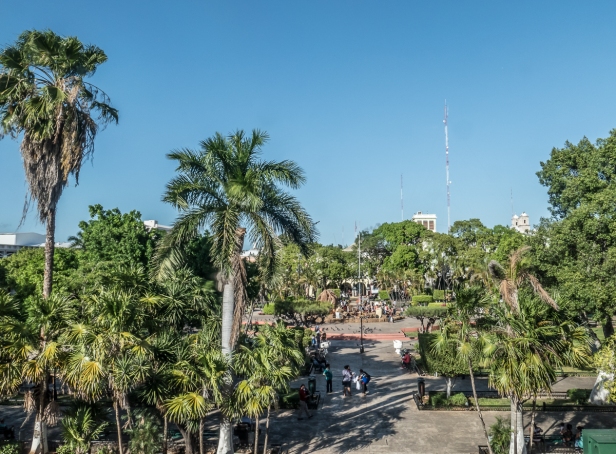
15-22 Dec 2016. We travel by bus from Playa del Carmen to Merida, the capital of the state of Yucatan. We’ve rented an Airbnb apartment in Merida but are told to go to the home of the renter first. We climb into a taxi at the bus station and hand the driver a piece of paper with the address written on it. It looks like this: Calle 51 517 70 x 72
It’s totally confusing. Later we find out that there is a logical pattern to the numbered streets. All north-south streets are even numbers; all east-west streets are odd numbers. Thus the above address means house number 517 on street number 51, between streets 70 and 72. Once you understand how it works it all makes sense, and soon we become quite nonchalant when giving instructions to taxi drivers.
The woman who has rented us the apartment is ill so we are met by a teenage boy with no English. We follow him through the streets, trundling our cases over rough sidewalks, arriving after about five minutes at a tall wooden door in a blank white wall. The door has an equally tall metal gate in front of it. He unlocks the gate and the door and we step into the most wonderful shabby-chic Spanish colonial house. It has twenty-foot beamed ceilings, and tiled floors, and a courtyard garden out back. There’s a huge “medieval” stone seat in the bathroom, and the owner’s paintings on all the walls. It’s thoroughly charming.
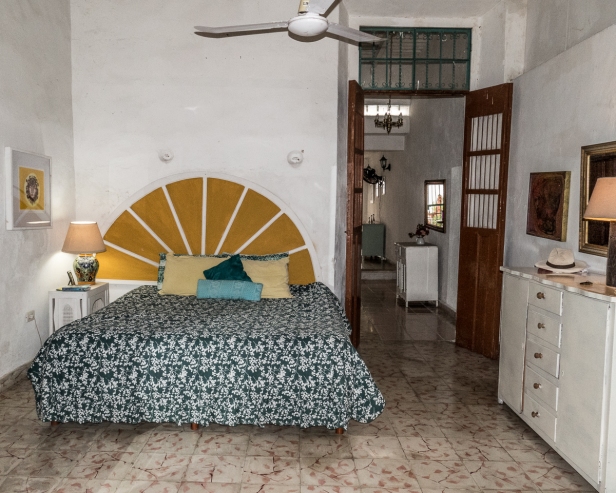

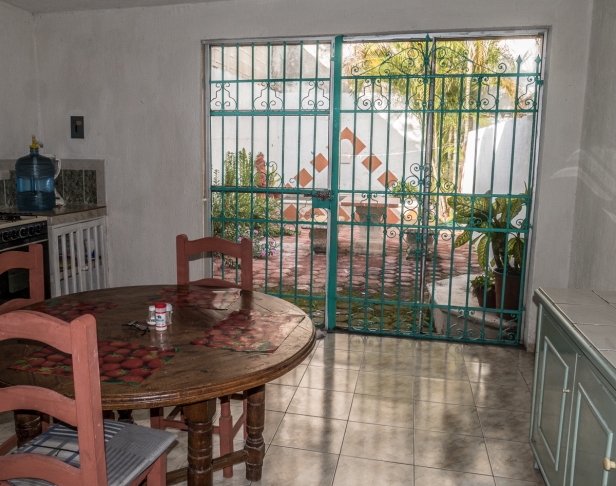
The boy shows us around. We have enough Spanish to grasp most of what he tells us, except where to find grocery stores. Later we discover that we’d really rather not use any of the pots, tableware, and cutlery in the kitchen until we’ve washed them all first. And there are holes in the screen to the garden so I’m dinner for mosquitoes every day until I cave and slather myself in bug dope.
Using Google we discover there is a Mega in Merida. It’s a supermarket chain we’re familiar with from our time in San Miguel de Allende and Playa del Carmen. Later that first afternoon we take a taxi to Mega, do a huge grocery shop, and then go out onto the street expecting to get a taxi home the way we always did in Playa and SMA. In SMA taxis would frequently pull into the Mega parking lot, and in Playa they would always be lined up so we never had to wait for one.
There is an attendant in the Mega parking lot in Merida, but no taxis. We ask for the best place to get a taxi. He points towards the street. We are facing two major four-lane roads overflowing with rush-hour traffic. There are infrequent taxis going by and all those we see are occupado. For twenty minutes the man tries to help us flag down a taxi, but to no avail. We decide to go back into the store and ask the woman at the service counter to phone us a cab. She spends five minutes or more on the phone only to tell us that it’s not possible. We are truly stranded. We have no idea where we are really. We certainly have no idea how to get home by public transport.
Back outside the parking lot attendant continues to help us flag down a cab. After another twenty minutes one finally pulls up in front of us. The trunk pops open and the driver gets out of the car. I’ve already started loading our groceries into the trunk. He says to me Señor Ortega? No, I say, as I continue loading groceries. Possession is nine tenths of the law and all our groceries are in the trunk. After some rapid-fire discussion with the parking lot attendant the driver agrees to take us home. With great relief we tip the parking lot attendant and climb into the cab. Apparently Señor Ortega had been able to phone for a cab, and I hope one arrived for him eventually.
All in all it is not an auspicious start to our week in Merida.
Our apartment is about a twenty-minute walk from the centre through mostly deserted streets. A couple of them look like this.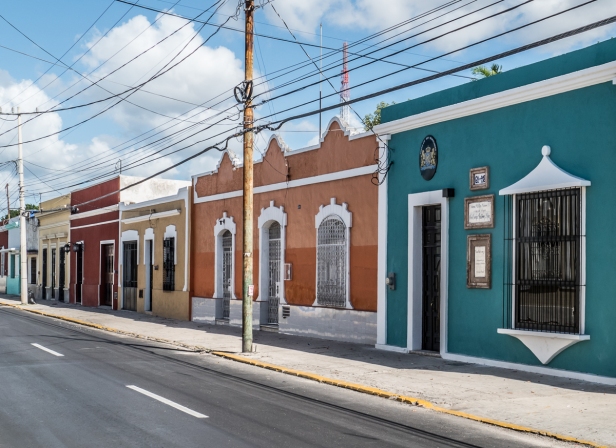
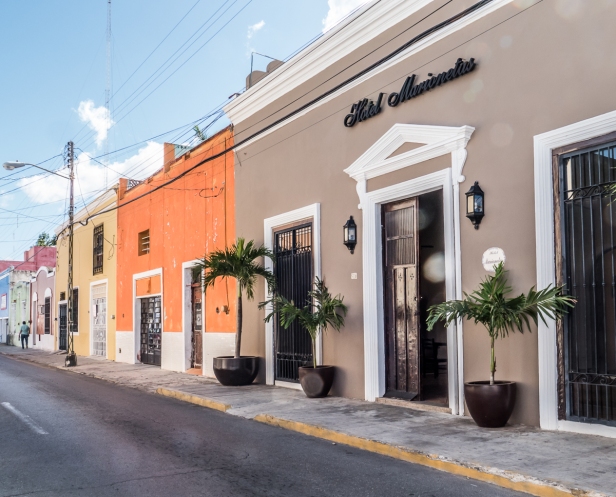
The rest are all in the same traditional Spanish colonial style but much shabbier with peeling and very faded paint. It’s not unattractive, but there is little feeling of life on the streets in our neighbourhood. It feels almost deserted. Everyone is enclosed in privacy behind solid walls, and traffic is sparse.
On Friday evening, and again on Sunday evening we go to the zocalo, or town-square, looking for life. There are plenty of people around but not much happening, although on Sunday night there is a group of kids showing off their hip hop moves to loud music. We watch for a while entranced by their athleticism and bravado.
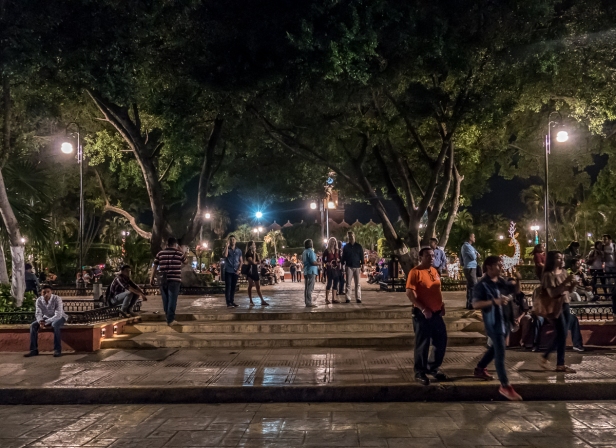
On Saturday night we go for a stroll along the imposing Paseo de Montejo. It was built during Merida’s prime at the end of the 19th century to emulate the grand boulevards of Europe like the Champs Elysées, and the Paseo de la Reforma in Mexico City. Here the wealthy families built their mansions when Merida flourished from the sisal trade. Sisal was used for making ropes but with the invention of artificial fibres the wealth of the city declined, leaving behind this remnant of a more affluent time.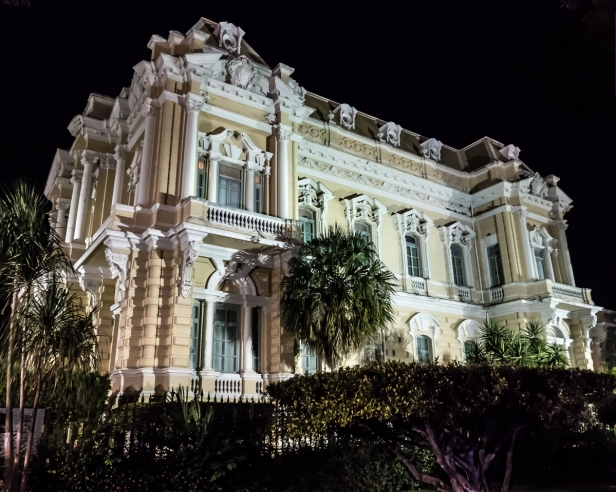
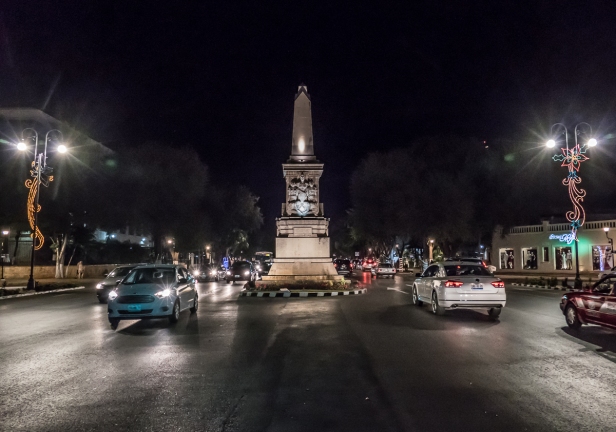
Christmas decorations on the way to Paseo de Montejo,

some unexpected street art,
and some lovely small green spaces in the central core.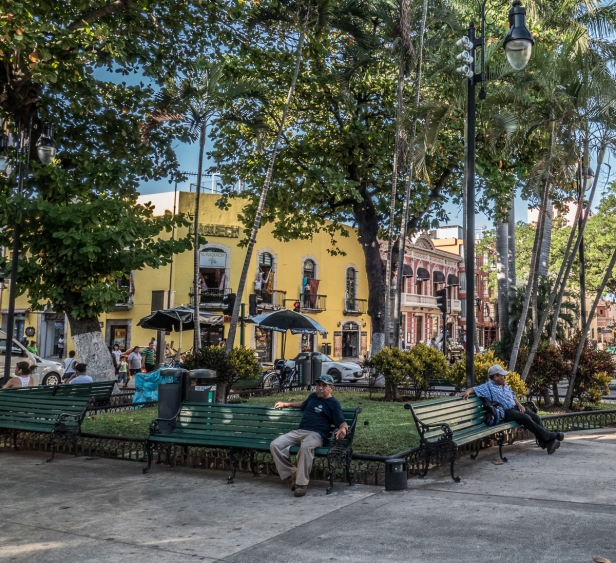
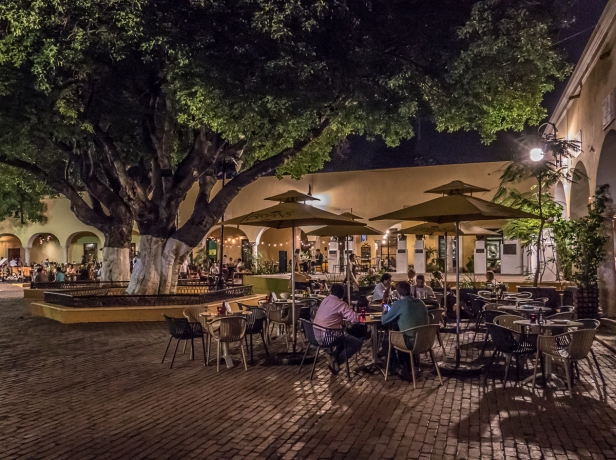
The zocalo in Merida is very typical of Spanish colonial towns: a wide green square where people come to meet, to hang out, to catch up on gossip, to while away the time with friends and neighbours, sitting in the shade of practically the only trees in town. Almost always on one side of the zocalo is the cathedral, and on the other three sides colonnaded government buildings with banks, cafes, and restaurants at street level.
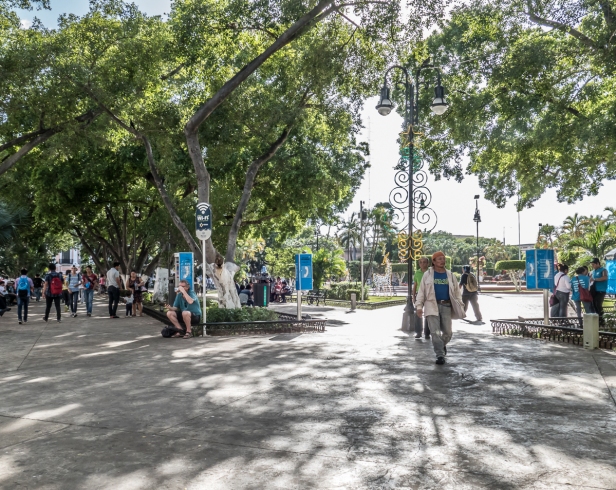
On one side of the zocalo is La Casa de Montejo built in 1549 and now a museum. We wander slowly through the opulent rooms that are displayed as they would have been when the Montejo family lived there.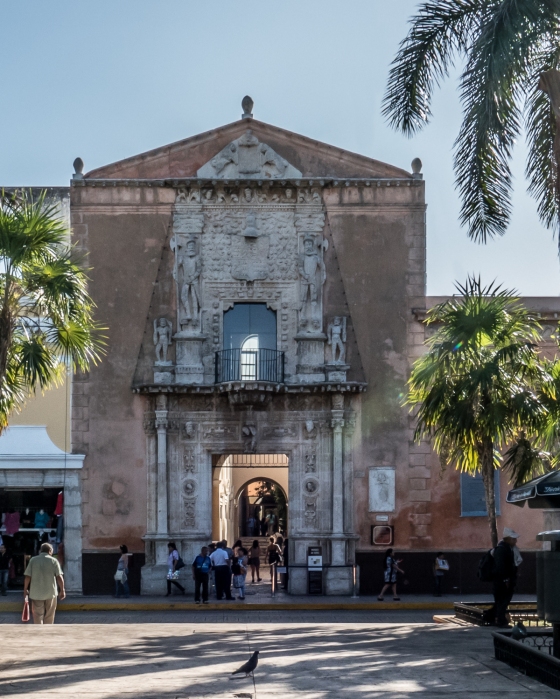
One day passing by in a taxi I see this charming plant shop.
The zocalo, and the beautiful architecture, and the lovely green spaces are also very charming, but nevertheless we are not charmed by Merida.
There are a number of things about Merida that leave us disappointed. We are outside the central core and walking is very painful for me. We don’t feel like we can just set out on a long walk exploring the town. Taxis are always a problem. I suppose we’ve been spoiled by the mad abundance of taxis in SMA and Playa del Carmen where you get one within seconds. In Merida it almost always takes us ten minutes or more, and feels like a crapshoot as to whether or not one will come by on the almost deserted streets. I know ten minutes is nothing, but we are expecting it to be easier so it is an adjustment, and always feels faintly problematic.
I read a brilliant account of the Merida markets. This sentence sums it up: It was chaos. Mérida had taken the jigsaw puzzle called “Shopping”, hacked up the pieces with scissors, stuffed them into a piñata, and then hit it with a rocket launcher. So of course I want to go to the markets! We wander around for a while, but again we are disappointed. I suppose I’m not in a mood to be much pleased by anything. I was hoping for, expecting, something like the Tlacolula market, something more exotic, more indigenous. Despite my lack of enthusiasm I still find plenty worth photographing though I feel little inspiration or confidence.
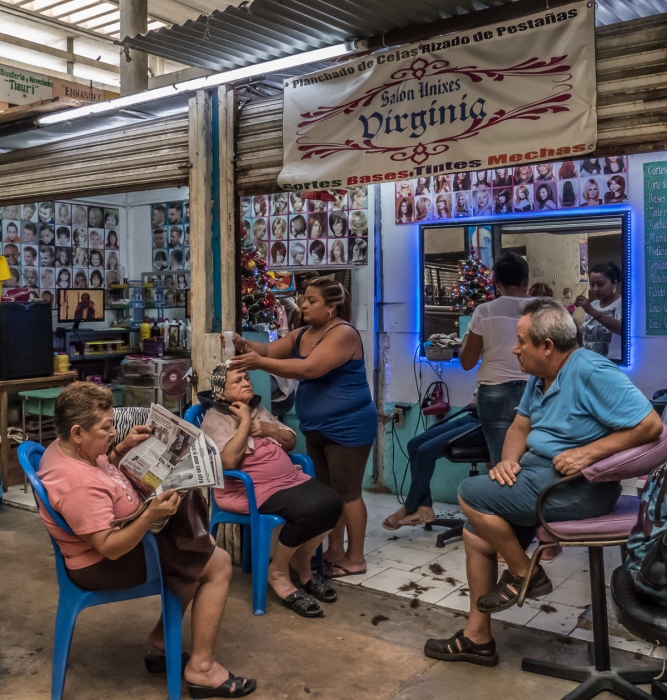


If there is no life on the streets in our neighbourhood, we certainly find it in and around the markets. The streets are overflowing with people, heaving humanity all full of life and errands and Christmas shopping.
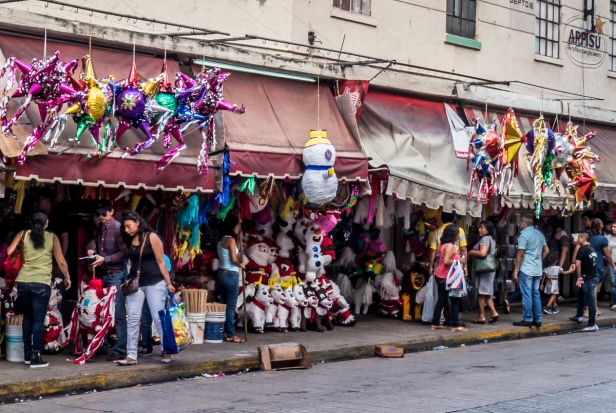
Don especially is looking forward to going to the Museum of the Mayan World. This is his Trip Advisor review:
The Gran Museo del Mundo Maya is located a long taxi ride from the centre of Merida. My wife and I had been looking forward to getting a primer of Mayan history before going to visit some of the Mayan cities like Chichen Itza and Ek Balam, but the Gran Museo failed to provide that. The one video we saw was in Spanish only, and the general layout of the museum was not helpful towards our goal of learning more about Mayan history. After we finished seeing the exhibits we wanted to have a coffee, but the coffee bar, which is hidden away on the 4th floor, was closed. Overall it was a big disappointment.
I suppose I am wanting to see something like the full-size dioramas of the Nubian Museum in Aswan, Egypt that really brought to life the traditional lifestyle of the Nubians.
We very much want to see the flocks of flamingoes at Celestún, an easy day-trip from Merida. I’ve read online that some tours, after a two-hour journey from Merida, only include one hour on the water watching the flamingoes and other birds, and exploring the mangrove swamps. Don finds the Nomadis Hostel, and a man at the reception desk there speaks good English. He can book a tour for us. I ask him first will he phone to confirm that there will be more than an hour on the water. After phoning he assures us that we’ll be out in the boat for two or two and a half hours. We are delighted and book the trip. But no. We are only out on the water for one hour and are then taken to have lunch and play on the beach at Celestún for two hours. It’s pleasant enough but not what we’d signed up for.
The woman who owns the apartment is not well, and we understand this, but we nevertheless feel a bit abandoned, and when we phone to ask her to order a taxi for us to get back to the bus station on our final day in Merida we can’t get her to understand even though we’ve had previous conversations with her in English. So we walk to the Nomadis Hostel and asked if they’ll phone for a taxi for us, and they basically say it can’t be done, and that the taxi company they use wouldn’t necessarily be reliable. So on our last day we trundle our cases to the nearest intersection and wait. Hopefully. Anxiously. Trusting as best we can. Sure enough within less than 10 minutes a taxi appears and gets us to the bus station in plenty of time.
We ride the bus to Valladolid, a two-hour journey.
Over the week in Merida my head becomes increasingly itchy. I put it down to mosquito bites, and resist scratching. Finally in the bathroom in Valladolid there is enough light for me to see it is not mosquito bites but some heinous rash, all over my head. Ewwwww. I can only think it came from the pillow in Merida. Don carries an anti-allergy pillowcase with him and it probably saved him from the same fate. Thank God it’s not contagious. I swab my head daily with antiseptic shampoo. It takes a week to wash Merida out of my hair.
And finally – that first evening in Valladolid I discover I’ve left not only my spare camera battery, but also the battery charger plugged into a wall socket in the house in Merida! As soon as I realize what I’ve done I get that sinking feeling. We all know that expression, but it’s the first time for me that I actually feel it. There is a visceral sense of sinking in my guts. I didn’t know it could be so literal. So we spend our first full day in Valladolid on the bus to and from Merida to retrieve them. Merida couldn’t please us, and then it didn’t want to let us go.
Next post: From Valladolid we do an overnight trip to Rio Lagartos and this time we get to spend three hours on the water. Flamingoes! Pelicans! Crocodiles! Yeah!
All words and images by Alison Louise Armstrong unless otherwise noted
© Alison Louise Armstrong and Adventures in Wonderland – a pilgrimage of the heart, 2010-2016.

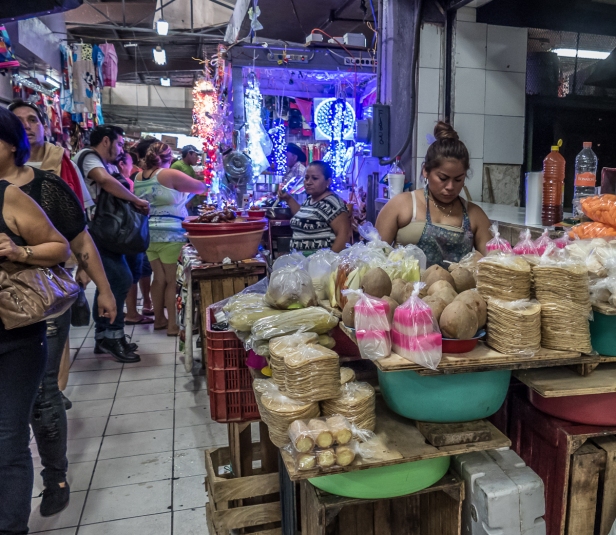
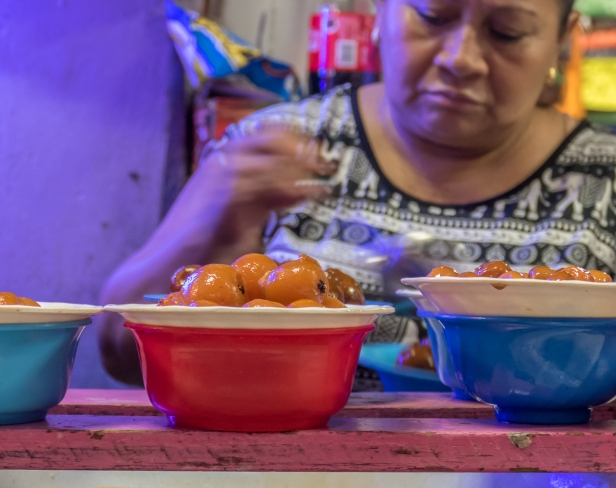



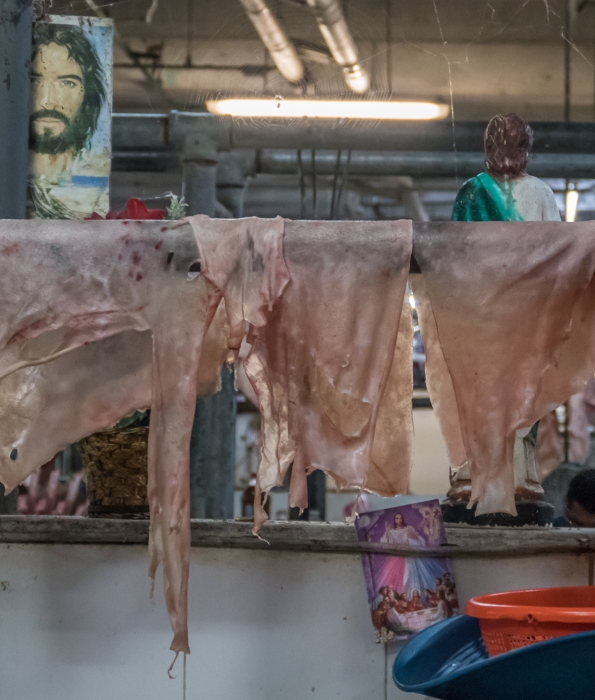
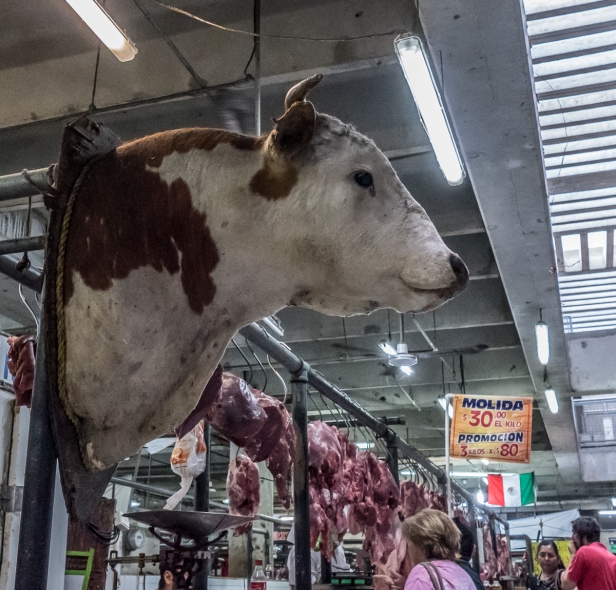
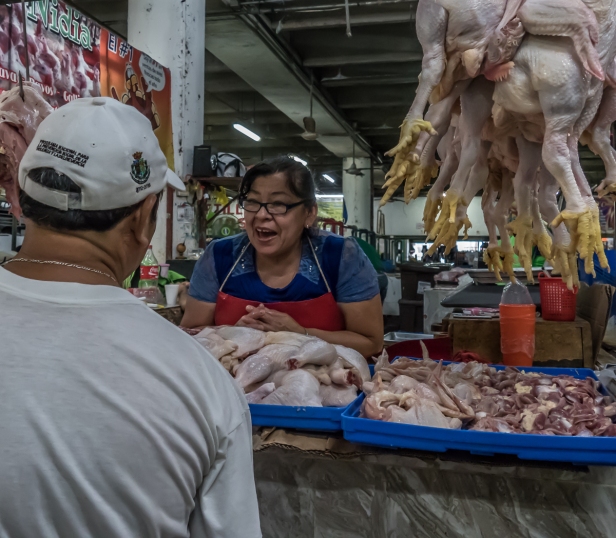

Hi Alison, At last a place you have visited and written about that I don’t have to put on my list! Sorry I have to look on the bright side. The Air BnB and squares look lovely.
I’ve been away from a PC for a week (bliss actually) and am looking forward to some of my Summer holiday catching up reading posts and back end work on my blog. Looking forward to seeing your flamingos…. Louise
LikeLiked by 1 person
There’s much that’s lovely about Merida. I think it was the combination of not being able to walk much, the difficulty with taxis, and then the disappointment with the museum and with the tour to Celestun. On the plus side we’ve loved Valladolid, and the boat tour at Rio Lagartos was sensational – all to come in future posts.
Alison
LikeLike
About 10 or 12 years ago we had a very different experience with Merida. But we were there over Easter so there was a lot of activity, including the reenactment of a Mestizo wedding in the square in front of the zokolo. There was a lot of celebrating every night. We were told that the impressive zokolo there was initially intended for one of the South American capitals – Bolivia I think- but the plans got mixed up and Merida got the big cathedral while the other place got the more modest edifice. We found an interesting venue every night for some ethnic dancing or singing etc and were told there was a cultural activity somewhere in Merida every night. We enjoyed our stay there very much. The one difficulty we had was getting money out of an ATM outside of Canadian banking hours which caused us some concrrn on the day we were leaving. However, it turned out ok.
LikeLiked by 1 person
It sounds like you got to experience the Merida we were hoping for, and it sounds wonderful. Merida had been recommended by several people, but it just didn’t work out for us. We asked at the tourist information centre more than once for activities in town, and looked a lot online of course, but didn’t find anything. I guess it was just a quiet time of year.
Alison
LikeLike
Eeeek! I was there in 1970 when I was around 14, and my daughter went by herself at 24 a few years ago pretty much without telling me…… She loved it! I did too, but when I was there it was jungle. You could climb in and out of the pyramids and astronomy domes with no one there. Your photos show me how much it has changed and developed. You photos and story bring back lots of memories. I ate snake soup there, not on purpose, and just thinking of it, even after I was home, sent me running to the bathroom!
LikeLiked by 1 person
I can imagine it was very different back then. We saved visiting Mayan ruins until we got to Vallodolid since the ones we wanted to visit (Ek Balam and Chichen Itza) are closer. But even Merida must have been amazing back then. It’s a big city now. Hmmmm snake soup. I don’t think I’d have such a strong reaction, having eaten crocodile in Australia. Eh, one reptile’s much the same as another 🙂
Alison
LikeLike
Not all destinations are equally charming. I was surprised to see vegetables at the market packed up in plastic bags. I think you and Don expressed your feelings about the place perfectly when you chose to post the pig and cow heads and the chicken feet right after.
LikeLiked by 1 person
Lol, I always love the animal parts at “third world” markets. I love how everything is not so secret and sanitized. I wonder what happens to the pig head? Vegetables in plastic bags is definitely unusual in these kinds of markets. Merida came highly recommended, and I can see attractiveness of it, but it just didn’t work for us.
Alison
LikeLike
Sorry to hear that Merida was a disappointment, and on top of that a rash (yuck!) and unexpected return. You did get some great photos though—pig’s head photo is awesome (in a creepy way). Hope things improve.
LikeLiked by 1 person
Thanks Caroline. I think the whole meat section of these kinds of markets is my favourite – it’s so blatant! Things have improved considerably. We just spent 12 days in Valladolid and loved it. It’s so rare for us to not enjoy a place, but Merida was difficult for us.
Alison
LikeLike
I know well the sinking feeling, it is quite literal. I am very sensitive. Well glad you have moved on from Merida. 🙂
LikeLiked by 1 person
Actually right now we’re back in Merida! We spent 12 days in Valladolid and really enjoyed it. We’re now back in Merida for a day and a half on our way to Campeche.We’ll use the time to have a bit of a rest though who knows? Maybe we’ll suddenly discover something about Merida that excites us. It was very interesting for me to be so aware of the sinking feeling. It really was like something sank to the bottom.
Alison
LikeLiked by 1 person
sorry to such a non-merriment holiday, Alison.
glad you captured the atmosphere with words
and images with all the battery power available.
but most grateful you survived to tell the tail
on chaos, inconvenience and itching!
may you both experience ease, healing
and more fun in 2017, david 🙂
LikeLiked by 1 person
Thanks David
glad to have survived 🙂
things improved
battery back itching gone
healing happening
mucho flamingoes in Rio Lagartos!
peace and joy for 2017
Alison
LikeLike
Your photos have brought back such fond memories of our stay in Merida last winter. So sorry to hear you did not enjoy your time there. Although we were in the Old Town area, our accommodation was close to a taxi stand, groceries, and a small but busy market. Quite unlike the main market in the centre of the city thank goodness. I went to the one featured in your photo once and decided it wasn’t for me and never went back. Much too chaotic. I look forward to reading your thoughts on Valladolid.
LikeLiked by 1 person
We’re actually back in Merida for a couple of days on our way to Campeche and already we’re enjoying it more. We’re staying at a very cool hostel (in a private room) and have been given all the info we should have gotten at the airbnb – a grocery store close by, and a much shorter walk to the Centro. We loved Valladolid and did a lot of excursions from there to Mayan ruins and cenotes and to the flamingoes at Rio Lagartos. It all seemed to work for us there in a way that it didn’t in Merida.
Alison
LikeLike
The place seems very nice!
LikeLiked by 1 person
Yes, it really is very nice. Sadly it just didn’t work for us.
Alison
LikeLike
What an adventure, the place looks nice though specially the market.
LikeLiked by 1 person
Oh it’s really a lovely city in the Centro, and yes it was definitely an adventure. I’ve been to so many local markets, and usually find them fascinating. I think I was just not in a mood to enjoy anything at the time!
Alison
LikeLiked by 1 person
aw! sorry to hear about Merida, but the place looks good anyways, safe travels you two! Happy new year.
LikeLiked by 1 person
It just didn’t work for us. There was no one there to help us find a local grocery store or help with day trips and exploration. So we muddled along as best we could. Valladolid was much better. Safe travels to you guys too, and Happy new Year.
Alison
LikeLiked by 1 person
Thanks Alison, happy new year too, keep safe and enjoy!
LikeLiked by 1 person
I have a deep suspicion of landlocked towns LOL I am a water baby and love the architecture of the sea. I am currently without any wild water or even a pool… good thing there is monkeys and South African wine! You photos make it very appealing though, perhaps they should hire you? 🙂
LikeLiked by 1 person
Thanks Donnae. It’s not a bad place, it just didn’t work for us. I too love being by the water. Hope things are going well for you in Africa, and that you’ve recovered!
Alison
LikeLiked by 1 person
After our time in Playa del Carmen, Merida was a welcome change but, like you I have mixed feelings about our time there. We were lucky enough to stay in a BnB run by an American expat and met a few friends (we still keep in touch with one gentleman who just turned 84) during our month-long stay and, with the help of the landlord’s phone and Spanish, getting a taxi occasionally was doable. We spent a lot of time going by bus to the nearby willages and the Mayan ruins. But I remember the dead cat decomposing on a nearby side street (the whole month), the garbage and litter, and making the endless walk every day or 2 in the relentless heat to get groceries, to get to the bus station, to get anywhere. The street crush of people around the market and our experience at the market itself was a sensory overload of interesting mixed with more people everywhere, narrow lanes filled with junk and all the “plastico” you could want and the hanging meat – enough to turn me into a temporary vegetarian! So yes, onward to Valladolid! 🙂 Anita
LikeLiked by 1 person
Sounds like you had some of the same issues we did, but at least at your BnB you got to meet some people, and had people to help you with taxis a little. We were pretty much abandoned by our host. And yes, the endless walking to get anywhere. The dead cat sounds horrific! I guess I was just not in the mood for that market. We’ve just had 12 very satisfactory days in Valladolid with excursions to Mayan ruins and cenotes. And could get a taxi pretty much immediately whenever we wanted one!
Alison
LikeLike
I’m truly grateful for this post. I had other visions of Merida in my head. You’ve saved me. I don’t think I could deal with the frustrations of the taxi situation and getting around.
I love your description quote of the market. I got tossed out of one in SMA when I was asked if I was going to buy something or just take photos. I was too honest. Vamonos!
LikeLiked by 1 person
I’m glad it was helpful. Merida’s certainly not all bad, but there is always the endless walking to get anywhere, and the hopeless taxi situation. Maybe if we were staying at a hotel right on the zocalo we’d have had an easier time with the taxis. We certainly found in Valladolid that we never had a problem. I can’t believe you got tossed out of a market just for taking pictures!
Alison
LikeLike
Oh that’s too bad but then any place that hangs the cow’s and pig’s head like that (in a butcher shop)… It does look like a colorful place physically, which can be deceiving I suppose. Hugs to you both. 🙂
LikeLiked by 1 person
I’ve seen animal heads in many markets around the world. I guess I kind of expect it now. Still can’t resist photographing it all though 🙂
Apart from the whole issue to do with simply getting around, and the scarcity of taxis, I think Merida was a bit of a shock for us after six weeks at the beach. I think we hadn’t yet quite got our travel legs under us. We made up for it in Valladolid though.
Hugs to you too
Alison ❤
LikeLike
Shame. Guess we all have those times when things just don’t go right, but it looks lovely from your photos.
LikeLiked by 1 person
Yes, it was just one of those times. Nothing seemed to work out for us. It was a bit of a shock really since we’re usually so lucky. Oh well. We moved on. Valladolid was really good. Parts of Merida are indeed very lovely.
Alison
LikeLike
Triple ouch, Alison. Especially about the head. I experienced a similar fate from a motel in Portland. And the camera battery. I just went through that on a Polar Express trip in Essex, Connecticut. Dropped the $50 puppy and couldn’t find it. I’d given up whenPeggy discovered it had fallen in the fur top of her boot! I really liked Chichen Itza when Peggy and I visited. We stayed at a hotel next door and spent a late evening out there after everyone had gone home. Magical. The pig wins the prize. I took a similar shot it Portugal and Peggy wanted to know why I had taken it, not really getting I couldn’t resist! 🙂 –Curt
LikeLike
Yeah, that head rash was seriously baffling. I’ve never had anything like it. That’s too funny that your battery was in Peggy’s boot! But good yes since you got it back! It sounds like you had a fabulous time at Chichen Itza. We got there really early before the crowds came and we’re so glad we did. I actually have photos with almost no people in them. I totally get why you photographed the pig 🙂
Alison
LikeLike
Peggy understands live pigs. 🙂 We had the same experience at Chichen Itza, lots of intriguing, people-free photos. It was pre-digital (was there ever such a time?), but I have them stuffed away somewhere… –Curt
LikeLiked by 1 person
It’s too bad that a lot of things didn’t go right, although the place looks quite charming from your photos. Hope you have better luck elsewhere!
LikeLike
Thanks Xelca. Merida was recommended, and I think many people like it very much, and parts of it certainly are very charming, it just didn’t work out for us. We had much better luck in Valladolid!
Alison
LikeLike
Wow wow wow; sometimes a particular place seems to do all things possible to kick us down that trail. I loved the ‘artist’s apt’ – too bad she was sick….
The rash – eek – that would have made it twice as itchy for me… ‘Pica pica!’
The photos were wonderful, even if they trigger unpleasant memories for you!
LikeLiked by 1 person
Thanks Lisa. I think part of it was me just being miserable, but definitely getting around was difficult, and we were disappointed with some of the experiences there. The rash was just plain weird. I’ve never seen anything like it and I have no idea what it was. Ewwwww! It’s all better now thank goodness.
Alison
LikeLike
Alison my heart ached for you at the description of the challenges. As to the sinking feeling of leaving something behind we are the masters of this. By miracles of human kindness we have always had our things returned. I had recently been thinking of a post called The Truth About Travel. Really it’s not always unicorns and rainbows is it?
LikeLiked by 1 person
Aww thanks Sue. Not all unicorns and rainbows that’s for sure! But we’ve been so lucky so it’s a bit of a shock when things start to go a little sideways. Ah, the truth about travel – it has occurred to me write about it too. Hard beds immediately comes to mind 🙂
Definitely a certain resilience is required.
Alison
LikeLiked by 1 person
Yes resilience, patience, flexibility and calmness all come to mind. 🙂
LikeLiked by 1 person
I like the looks of Merida (even though a city), and your apartment feels nice. I wonder if your suitcases have wheels? And how many you’re carrying this trip. I don’t think I can travel with one carry-on as many have done. Have you looked into Uber taxis? They may not be in Mexico, but they are surprisingly in many other places I’ve been recently: Amsterdam, Malta, and get this…Abu Dhabi! If Uber is available, it makes getting a cab almost fun…really. Get the app on your phone, and you can see if Uber taxis are available where you are (there’s a map that shows how close to you they are).
LikeLiked by 1 person
I like the looks of Merida too – there’s a lot here that’s quite charming. Oh yes our cases have wheels – carry-on size with spinner wheels, plus small backpacks for laptops and other valuables. Uber simply hasn’t occurred to us! Must get Don to look into it. There was one point we tried to phone for a taxi ourselves and could make ourselves understood but couldn’t understand what was being said to us.
Alison
LikeLike
do you carry only one each, do you carry them on or check them. I just found a spinner carry-on that tells you how much it weighs, and charges your laptop and phone…but costs $450! I want a good one, but that’s a little too good!
LikeLike
One case and one backpack each. We check the cases because we carry knives, scissors, and nail files – can’t count the number of times we’ve been glad to have them with us. $450! Yeah, that’s a little too good.
LikeLike
Yeah, that was my thought. I carry stuff they won’t let you carry on, too. Once, they confiscated my nail clippers! I actually said in frustration and disbelief, “what, you think I’m going to clip someone to death?” Then he showed me the fold-out file attached. But yes, I carry knives and pointy stuff, too. So, if you check it, why carry such a small bag?
For $450, the bag better make espresso, call Uber taxis by voice command, store chocolate at the right temperature in the jungle, and have sleeping quarters for a dwarf butler!!
LikeLiked by 1 person
Chuckle. Small because we still have to lug it around from airport to taxi to hotel up and down stairs, to bus station, etc. It’s easier the smaller and lighter it is.
LikeLike
Thanks for the suggestion re the Uber App BF. I’ve added it to my ever-growing number of apps on my phone.
LikeLike
I’m sorry to hear that Merida didn’t charm. Sometimes that just happens – I feel the same way about London and Dublin. At least you were able to get back to Merida and retrieve your items – most times you’d be off on a plane and unable to backtrack even if you wanted to.
LikeLiked by 1 person
It’s funny about different cities. I love London, but not a big fan of Rome though I know people who love it. Merida didn’t do it for us, not helped by the taxi situation. We did much better in Valladolid. We found it just as charming and never had a moment’s problem getting a taxi!
Alison
LikeLike
Isn’t it funny how some places just don’t resonate? There’s often no single, objective reason (although you had a few); there’s just a disconnect. I’m glad you have moved on and that you still managed to get some gorgeous shots of the town.
LikeLiked by 1 person
Thanks Lex. We found a fabulous hostel (with private rooms) in Merida and had they had room and we’d stayed there I think we’d have a had a whole different experience. We’re just there now again for 2 nights on our way to Campeche. They gave us a whole detailed list of activities/things to see in and around town with detailed info on where to get the collectivos, etc. The kind of info you need to be able to get a hold of a place for exploring. And then even for these couple of days I got a cold and couldn’t do anything but moan and snuffle in bed all day. Oh Merida – you really were out to get me! 🙂
Valladolid, OTOH was wonderful and I’ll post about that eventually.
Alison
LikeLiked by 1 person
Oh, my. Like life, travel isn’t always what you expect, right? But, I have to say that your photos, especially the night ones, make it look fabulous. Onward!
LikeLiked by 1 person
Thanks Susan. It’s really not an awful town, it just didn’t work for us. Since then we’ve spent 12 days in Valladolid which we rally enjoyed, and now we’re in Campeche and immediately thoroughly charmed. Onward proved to be the solution!
Alison
LikeLiked by 1 person
I read in your replies to some of the comments that you’re back in Merida now for a short while, staying in a better place and having a much better time. Made me think that perhaps we can brave uncomfortable days much better if we know there’s a nice home waiting to welcome us back to her arms at the end of the day.
LikeLike
We had another day and a half in Merida and it did seem nicer but I got a horrible cold so spent the day in bed! Merida got us coming and going! We are now in Campeche which must be one of the most beautiful towns I’ve been to – anywhere! We fell in love from the moment we arrived. And we have a lovely hotel here so yes we have the once home at the end of the day too!
Alison
LikeLike
What a huge disappointment! Merida seemed quite promising when we visited but it was only a one day and night stop during a ruins tour we were on in the region.
LikeLiked by 1 person
We’ve been to three inland Yucatan peninsula towns on this trip now, and Merida was our least favourite. We much more enjoyed Valladolid. And Campeche is wonderful. Campeche feels like a beautiful blessing. Just goes to show you can’t win them all.
Alison
LikeLiked by 1 person
We were able to spend a few hours in Campeche while on our Ruins Tour, due to another change in the schedule. I loved the time we spent there and told Terry we really needed to go back. We haven’t been to Valladolid.
LikeLiked by 1 person
Excellent.
Though I was a bit confused at first, because I’ve recently visited the other Merida in Spain 🙂
LikeLiked by 1 person
Thanks rabirius. I always categorize by country, but I suppose I should make it a bit clearer where we are. We’re going to Spain next summer – perhaps I’ll like the Spanish Merida more.
Alison
LikeLiked by 1 person
Well. It’s different. A bit like little Rome. I can recommend a visit.
LikeLike
Merida is a beautiful city, clean, the friendliest people, the downton square full of life, local people , and completely safe ..the restaurants, small boutique hotels are so nice and clean , the stores , lots of typical handcrafted objects, textiles, huipiles , guayaberas , handsewn bags, pillows ,jewelry,so many things…
Merida is called the WHITE CITY,for its clean streets and facades ,
i have been there many many times , if not beeing able to grab a taxi ASAP,well it is not NY city , you can use UBER .
To bad you did not like it.
LikeLiked by 1 person
Merida was recommended by several people, and it obviously has it’s charm. It just didn’t work well for us. We enjoyed Valladolid more, and totally love Campeche. I guess not every place appeals to everyone. Thank you for commenting. You obviously have a completely different, and wonderful, experience of Merida.
Alison
LikeLike
What an awesome trip… walking around in the town square at night looks so fun with everyone out and about!
LikeLiked by 1 person
We are having an amazing adventure, and I agree, the town square at night looks wonderful. I do admit that part of the problem for us in Merida was us! I guess we just weren’t in the mood! Merida was not all bad that’s for sure.
Alison
LikeLiked by 1 person
Hi, Alison and Don. This is my first time visiting your blog, already I see something familiar: a pig’s head in a market. I’ve seen it too in one of the cities in my country, a ‘third world’ country. LOL. Anyway, Merida looks lovely, I love the colorful buildings, quite contrary though to the fact that the street wasn’t lively. Sorry about your experience with the Airbnb and having to go back there when you wanted to get out already. I hope your travel gets better and better in the future 🙂
LikeLiked by 1 person
Oh Merida is lovely, just not the city for us where things just didn’t work out. I’ve seen pig’s heads in many markets around the world now. I’m pretty sure there’s another one on the blog in a post about Cambodia. Still can’t resist photographing them 🙂
I’m going to make sure to bookmark your excellent blog for when we finally get to explore Indonesia beyond Bali!
Since Merida we’ve been in Vallodolid for 12 days and it was wonderful, and now we’re in Campeche which we absolutely love.
Alison
LikeLike
I like how honest you are. This is what traveling is, not always just fun and success, and if you travel long enough (as I’m sure you two have), you’ll surely end up somewhere you don’t like at some point. But writing about it in an upbeat way is difficult! Which is why I avoid blogging about my negative experiences, I just don’t know how to let go of my grudge enough to write something coherent. So I admire you for your writing and also for going back for the forgotten items! (I wouldn’t have.) 🙂
LikeLiked by 1 person
Thanks TSMS. I’ve always felt it important to share the bad with the good. As you say, travelling is not always fun, and you’re bound to get to places you don’t like so much. Also my mood in Merida was not so good so of course that colours things. Oh I had to go back to Merida for the camera battery charger. Without it my camera is literally useless. It would have meant the end of photography for the entire trip. And the excursion back to Merida to get it cost much less than a new camera would.
Alison
LikeLiked by 1 person
It souds to be great travel !
I love travelling also 😀
I leave you my post about celebration of New Year’s Eve in Madrid
LikeLiked by 1 person
Oh yes, it’s always good to travel, even when we have not so good times. Your New Year’s Eve in Madrid sounds awesome!
Alison
LikeLike
Alison, I agree with you ! To travel is amazing thing which word offers for us. Yes – it was great 🙂 I invite to follow my blog – I am going to publish more post about my trips 😀
LikeLiked by 1 person
All the guidebooks rave about Merida, but I didn’t love it either. I could have easily skipped it. Your bird photos from the next post are awesome though!
LikeLiked by 1 person
Well thank goodness we’re not the only ones. Just looking at the photos I can see it’s charm, and it came recommended, but like you we could have easily skipped it. Then we got to Valladolid and immediately connected even though the centre is way less sophisticated than Merida. Thanks re the photos. I had fun 🙂
Alison
LikeLike
We’ve both had the great fortune to visit many colonial cities in Mexico so I guess we are colonial city snobs/experts at this time 🙂 I enjoyed Valladolid especially in the evening when the day-trippers were gone. We also stayed at a great guesthouse there which can make all the difference sometimes.
LikeLiked by 1 person
I think where you stay is so important. We felt so isolated in Merida – from everything, even grocery stores. In Valladolid we were in a hotel right on the zocalo (there’s a story about that too – in the next blog post to come) so we were central to everything. It felt much better.
A.
LikeLike
Am so sorry you didn’t discover Uber. It has made our 2-month stay so much more enjoyable. Not only is it amazingly efficient and inexpensive, but the drivers are extremely friendly and helpful. I understand some of your frustrations, but fortunately we have been able to balance them with the positive being here longer. We are in a working class neighborhood about a 10-minute walk from the main square and sometimes it is loud, but feels authentic and festive. Am glad that the rest of your travels were better for you!
LikeLiked by 1 person
I wish we’d thought of Uber too! And it sounds as though you’re in a much better location than we were. Your neighbourhood sounds great. I certainly don’t entirely blame Merida for how it was for us – there were several factors, and sometimes things just don’t work out the way you want them too. Things have been much better since!
Alison
LikeLike
Sorry to hear you weren’t enchanted with Mérida, we had a fabulous time there. We were staying pretty central, but we had to go to the bus terminal several times and Uber was a lifesaver! There were always cars available and it was cheaper than a taxi. It helped us a lot in Mexico!
LikeLiked by 1 person
I don’t know why we didn’t think of uber. Just not used to it I guess. I’m sure it would have helped but we were so used to there being taxis readily available that we were frustrated by how difficult Merida was for us. We didn’t hate it, it just didn’t sing for us. Currently we’re in Havana and love it.
Alison
LikeLiked by 1 person